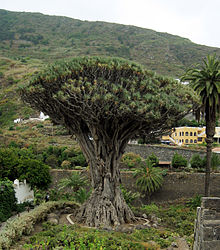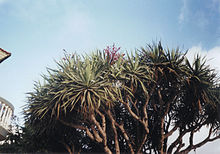- Dracaena draco
-
Dracaena draco 
The ancient specimen at Icod de los Vinos, Tenerife Conservation status Scientific classification 
Kingdom: Plantae clade: Angiosperms clade: Monocots Order: Asparagales Family: Asparagaceae Subfamily: Nolinoideae Genus: Dracaena Species: D. draco Binomial name Dracaena draco
(L.) L.Synonyms - Asparagus draco L.
Dracaena draco, the Canary Islands Dragon Tree or Drago is a subtropical Dragon Tree native to the Canary Islands, Cape Verde, Madeira, and locally in western Morocco, and introduced to the Azores. This tree is the natural symbol of the island of Tenerife (Canary Islands, Spain), together with the Blue Chaffinch.[1]
Contents
Description
Dracaena draco is a monocot with a tree-like growth habit currently placed in the asparagus family (Asparagaceae, subfamily Nolinoidae).[2] It is not a real tree. When young it has a single stem. At about 10–15 years of age the stems stops growing and produces a flower spike with white, lily-like perfumed flowers, followed by coral berries. Soon a crown of terminal buds appear and the plant starts branching. Each branch grows for about 10–15 years and re-branches, so a mature plant has an umbrella-like habit. It grows slowly, requiring about ten years to reach 1.2 metres (4 ft) in height but can grow much faster.[3]
Being a monocotyledon, it does not display any annual or growth rings so the age of the tree can only be estimated by the number of branching points before reaching the canopy. The specimen called "El Drago Milenario" (the thousand-year-old dragon) growing at Icod de los Vinos in northwest Tenerife is the largest and the oldest living plant of this species. Its age was estimated in 1975 to be around 250 years, with a maximum of 365 years, not several thousand had previously been claimed.[4]
Uses
When the bark or leaves are cut they secrete a reddish resin, one of the sources of the substance known as Dragon's blood, used to stain wood, such as of Stradivarius violins. The Guanches worshiped a specimen in Tenerife, and hollowed its trunk into a small sanctuary. Humboldt saw it at the time of his visit. It was 70 feet (21 m) tall and 45 feet (14 m) in circumference, and was estimated to be 6000 years old. It was destroyed by a storm in 1868.[5] It has a number of traditional medicinal uses.[6]
Cultivation
Dracaena draco is cultivated in the horticulture trade and widely available as an ornamental tree for gardens, drought tolerant water conserving sustainable landscape projects.
Dragon's blood was also called “Indian cinnabar” by Greek writers.
References
- ^ Ley 7/1991, de 30 de abril, de símbolos de la naturaleza para las Islas Canarias - in spanish
- ^ Chase, M.W.; Reveal, J.L. & Fay, M.F. (2009), "A subfamilial classification for the expanded asparagalean families Amaryllidaceae, Asparagaceae and Xanthorrhoeaceae", Botanical Journal of the Linnean Society 161 (2): 132–136, doi:10.1111/j.1095-8339.2009.00999.x
- ^ Dracaena Draco Farm, http://www.dracaenadraco.com/, retrieved 2011-11-3
- ^ Magdefrau, K. (1975), "Das Alter der Drachenbaume auf Tenerife", Flora 164: 347–357
- ^
 "Dracæna draco". New International Encyclopedia. 1905.
"Dracæna draco". New International Encyclopedia. 1905. - ^ Gupta D., Bleakley B., Gupta R.K. "Dragon's blood: Botany, chemistry and therapeutic uses" Journal of Ethnopharmacology 2007 115:3 (361-380)
Bibliography
- Bañares, A. et al. (1998). Dracaena draco. 2006. IUCN Red List of Threatened Species. IUCN 2006. www.iucnredlist.org. Retrieved on 11 May 2006. Listed as Vulnerable (VU A1abcde v2.3)
- Arkive: Dracaena draco factsheet.
- Dracaena draco in Morocco (photo gallery).
- The climate requirements for Dracaena draco defined by its borders: Northernmost tree in the world, near 40°, northern Azores Islands and Southernmost dragon tree in the world, near 38°, Victoria, Australia (photos).
- Benabid, A. & Cuzin, F. (1997). Dragon tree (Dracaena draco subsp. ajgal Benabid et Cuzin) populations in Morocco: Taxonomical, biogeographical and phytosociological values. Comptes Rendus de l'Academie des Sciences Serie III Sciences de la Vie 320(3): 267-277.
External links
 Media related to Dracaena draco at Wikimedia Commons
Media related to Dracaena draco at Wikimedia Commons  Data related to Dracaena draco at Wikispecies
Data related to Dracaena draco at Wikispecies
Wikimedia Foundation. 2010.


